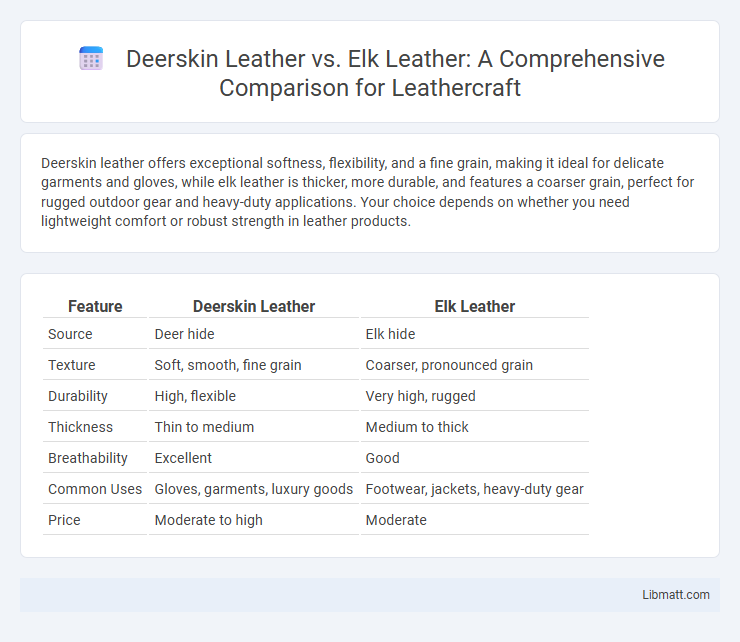Deerskin leather offers exceptional softness, flexibility, and a fine grain, making it ideal for delicate garments and gloves, while elk leather is thicker, more durable, and features a coarser grain, perfect for rugged outdoor gear and heavy-duty applications. Your choice depends on whether you need lightweight comfort or robust strength in leather products.
Table of Comparison
| Feature | Deerskin Leather | Elk Leather |
|---|---|---|
| Source | Deer hide | Elk hide |
| Texture | Soft, smooth, fine grain | Coarser, pronounced grain |
| Durability | High, flexible | Very high, rugged |
| Thickness | Thin to medium | Medium to thick |
| Breathability | Excellent | Good |
| Common Uses | Gloves, garments, luxury goods | Footwear, jackets, heavy-duty gear |
| Price | Moderate to high | Moderate |
Introduction to Deerskin and Elk Leather
Deerskin leather is renowned for its soft texture, natural elasticity, and fine grain, making it ideal for gloves, apparel, and upholstery. Elk leather features a thicker, sturdier composition with a distinctive grain pattern, offering enhanced durability and rugged aesthetics favored in outdoor gear and heavy-duty clothing. Both types are prized for their unique characteristics, with deerskin emphasizing suppleness and elk leather prioritizing toughness.
Source and Harvesting of Deerskin vs Elk Leather
Deerskin leather is sourced from the hides of deer, primarily harvested through regulated hunting and wildlife management to ensure sustainable populations. Elk leather comes from elk hides, often obtained from wild herds or ranches where elk are raised under controlled environments to maintain leather quality. Both types of leather undergo careful processing to preserve the natural strength and softness unique to their species.
Physical Characteristics and Texture Comparison
Deerskin leather is renowned for its soft, supple texture and fine grain, offering a lightweight yet durable material ideal for gloves and garments requiring flexibility. Elk leather features a coarser grain with a thicker, more robust structure, providing exceptional strength and a unique rugged appearance suited for heavy-duty use. Both leathers exhibit natural oils that enhance moisture resistance, but deerskin maintains superior elasticity while elk leather offers greater durability under stress.
Durability and Strength Differences
Deerskin leather offers exceptional softness and flexibility but is generally less durable and strong than elk leather, which features a coarser grain and thicker hide, providing superior toughness and resistance to wear. Elk leather is ideal for heavy-duty applications such as rugged gloves and outerwear, while deerskin suits lighter, more delicate uses like gloves requiring dexterity and comfort. Your choice depends on whether you prioritize durability for demanding conditions or softness for comfortable, everyday wear.
Comfort and Flexibility in Use
Deerskin leather offers exceptional comfort and flexibility due to its fine grain and soft texture, making it ideal for gloves and apparel that require dexterity and a snug fit. Elk leather, while slightly thicker and more durable, provides a balance of strength and suppleness, suitable for heavier-duty garments and gear without sacrificing too much flexibility. Both leathers excel in comfort, with deerskin favoring a softer, more pliable feel and elk offering robust resilience with moderate flexibility.
Breathability and Moisture Resistance
Deerskin leather offers superior breathability due to its fine grain structure, allowing for better air circulation and moisture evaporation, making it ideal for garments requiring comfort in warm conditions. Elk leather, while durable and thick, is less breathable but excels in moisture resistance thanks to its dense fibers that repel water effectively. Both leathers provide unique advantages, with deerskin favoring ventilation and elk leather prioritizing protection against moisture intrusion.
Appearance and Color Variations
Deerskin leather presents a soft, smooth texture with a fine grain and typically comes in pale beige to light tan hues, offering subtle natural color variations. Elk leather features a coarser grain with a more pronounced texture, exhibiting deeper tones from medium brown to rich chestnut that enhance its rugged aesthetic. Both leathers provide unique visual characteristics appealing to different styles, with deerskin favored for its sleek look and elk prized for its bold, rustic appearance.
Common Uses for Deerskin and Elk Leather
Deerskin leather is commonly used for gloves, clothing, and soft accessories due to its softness, flexibility, and durability. Elk leather is favored for rugged items like boots, belts, and motorcycle gear because of its thickness and abrasion resistance. Your choice between deerskin and elk leather depends on whether you prioritize comfort and dexterity or heavy-duty protection.
Care, Maintenance, and Longevity
Deerskin leather requires gentle cleaning with a damp cloth and occasional conditioning to maintain its soft texture and prevent drying or cracking, while elk leather is more durable and resistant to wear, needing less frequent conditioning and cleaning. Both types benefit from avoiding prolonged exposure to water and direct sunlight to preserve their natural oils and flexibility. Over time, elk leather typically outlasts deerskin due to its thicker grain, making it ideal for heavy-use items, whereas deerskin offers a softer feel but may require more attentive care to ensure longevity.
Price Point and Value Considerations
Deerskin leather generally commands a higher price point than elk leather due to its softness, fine grain, and durability, making it ideal for premium gloves and apparel. Elk leather offers a more affordable option with robust strength and natural texture, providing excellent value for rugged outdoor gear and heavier use items. Buyers should weigh deerskin's luxurious feel against elk leather's toughness when evaluating overall cost-effectiveness and intended application.
Deerskin leather vs elk leather Infographic

 libmatt.com
libmatt.com